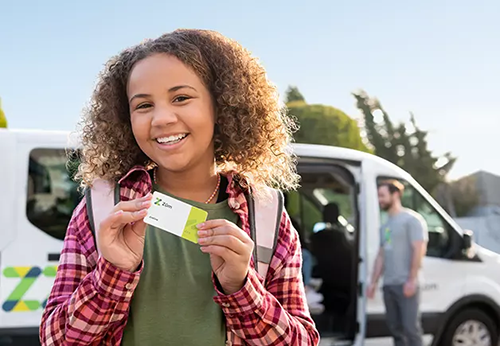What information is displayed on a bus card?
Zum Bus Cards hold unique codes assigned to a student. The cards have the student’s first name and last initial printed on them to help with identification in case they are misplaced.

Zum Bus Cards hold unique codes assigned to a student. The cards have the student’s first name and last initial printed on them to help with identification in case they are misplaced.

Students who are part of the bus card pilot program will receive their cards at school.
Zum Bus Cards are uniquely assigned to students and cannot be shared. Students will be provided with information on using the cards prior to the first day of use.
The schools selected currently receive bus service from Zum Services, Inc., which has the required hardware and software readily available.
Full details on the student bus card program are available online.
HCPSS is conducting a pilot program for a student bus identification card at several HCPSS schools that are serviced by Zum Services, Inc., which has the required hardware and software readily available.
Identified bus-rider students will be provided with an RFID (radio-frequency identification) Card, on which a student’s assigned bus is stored on a contactless chip in the card that will be scanned when a student gets on and off their bus.
To be eligible for bus service, your child’s home address must be outside of a school’s walk zones. Verify address eligibility by:
Parents/guardians whose children are eligible for bus transportation are asked to register to receive bus service each year. Families whose students have an Individualized Education Program (IEP) or a Section 504 plan that includes transportation do not need to register.
For the 2024-2025 school year, bus registration for all students is now closed.
Please note, per Howard County Board of Education Policy 5200 Student Transportation Implementation Procedures:
The Board of Education’s FY 2025 Requested Operating Budget proposes increasing the class-size by one at the middle and high school levels, with no changes at the elementary level. The proposed changes for the 2024-2025 school year would increase the student to staff ratio for middle and high school. The table below shows the current (2023-24) and proposed (2024-25) class-size ratios and upper ranges.
Once the County Council adopts the County budget in May, HCPSS will know the final funding allocation from the County. See What are the steps in the FY 2025 Operating Budget Process? for more information.
Because HCPSS’s fiscal year begins on July 1 and ends on June 30 each year, summer program funding falls across two fiscal years. Any summer programming that takes place before June 30 is part of the current fiscal year while programming after July 1 is funded by the next fiscal year’s budget. For example, Summer 2025 programming before June 30 is funded by the 2024-2025 (Fiscal Year 2025) budget while programming after July 1 would be funded by the 2025-2026 (Fiscal Year 2026) budget.